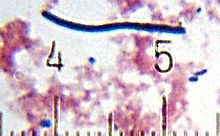Lactobacillus bulgaricus
| Lactobacillus bulgaricus | |
|---|---|
 |
|
| Scientific classification | |
| Domain: | Bacteria |
| Phylum: | Firmicutes |
| Class: | Bacilli |
| Order: | Lactobacillales |
| Family: | Lactobacillaceae |
| Genus: | Lactobacillus |
| Species: | L. delbrueckii |
| Subspecies: | L. d. bulgaricus |
| Trinomial name | |
|
Lactobacillus delbrueckii bulgaricus (Orla-Jensen 1919) Rogosa & Hansen 1971 Weiss et al. 1984 (subspecies status) |
|
Lactobacillus delbrueckii subsp. bulgaricus (until 2014 known as Lactobacillus bulgaricus) is one of several bacteria used for the production of yogurt. It is also found in other naturally fermented products. First identified in 1905 by the Bulgarian doctor Stamen Grigorov, the bacterium feeds on lactose to produce lactic acid, which is used to preserve milk.
Lactobacillus delbrueckii subsp. bulgaricus can be found naturally in the gastrointestinal tract of mammals living in Bulgaria, but one specific strain, Lactobacillus bulgaricus GLB44, is extracted from the leaves of the Galanthus nivalis (snowdrop flower) in Bulgaria as well. The bacterium is also grown artificially in many other countries.
It is a gram-positive rod that may appear long and filamentous. It is non-motile and does not form spores. It is regarded as aciduric or acidophilic, since it requires a low pH (around 5.4–4.6) to grow effectively. The bacterium has complex nutritional requirements.
Lactobacillus delbrueckii subsp. bulgaricus is commonly used alongside as a starter for making yogurt. The two species work in synergy, with L. d. bulgaricus producing amino acids from milk proteins, which are then used by S. thermophilus. Both species produce lactic acid, which gives yogurt its tart flavor and acts as a preservative. The resulting decrease in pH also partially coagulates the milk proteins, such as casein, resulting in yogurt's thickness. While fermenting milk, L. d. bulgaricus produces acetaldehyde, one of the main yogurt aroma components. Some strains of L. d. bulgaricus, such as L. bulgaricus GLB44, also produce bacteriocins, which have been shown to kill undesired bacteria in vitro.
...
Wikipedia
